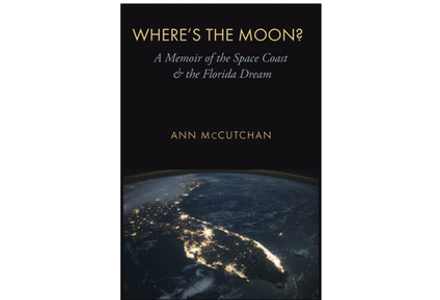A Look at Indie Authors and Their Publishers
By Lanie Tankard, Book Review Editor

Book: Where’s the Moon?: A Memoir of the Space Coast & the Florida Dream
College Station, TX: Texas A&M University Press, November 2, 2016 ($26.00 paperback, 224 pages, 29 B&W photos, index). ISBN 978-1-62349-450-6
Author: Ann McCutchan
Ann McCutchan is an essayist and journalist who concentrates on music, creativity, and place. The titles of her four previously published books illustrate these themes: Marcel Moyse: Voice of the Flute, The Muse that Sings: Composers Speak About the Creative Process, River Music: An Atchafalaya Story, and Circular Breathing: Meditations from a Musical Life. She has a sixth book under contract, a biography of Florida author Marjorie Kinnan Rawlings, titled The Life She Wished to Live. McCutchan, who holds degrees in both music and creative writing, is also a musician and librettist. She is collaborating with composer Andrew Rudin on a chamber opera to be performed in 2017 at the Center for Contemporary Opera in New York. Founding director of the University of Wyoming’s MFA creative writing program, McCutchan also taught creative writing at the University of North Texas, where she was editor of the American Literary Review.
Publisher: Texas A&M University Press
Texas A&M University Press (TAMUP), founded in 1974, annually publishes 60 books in a variety of fields, totaling over a thousand books in 42 years. TAMUP additionally markets and distributes almost another thousand titles published by eight other presses in the state as part of the Texas Book Consortium: Texas State Historical Association Press, TCU Press, University of North Texas Press, State House Press, Texas Review Press, Stephen F. Austin State University Press, Winedale Publishing, and Shearer Publishing.
The Association of American University Presses (AAUP), of which TAMUP is a member, lists more than 140 worldwide. These nonprofit presses, in addition to publishing, also advance knowledge, offer professional education, and advocate “free speech, academic freedom, copyright, and other core issues.”
Book proposal submission guidelines for TAMUP are on the website. Manuscripts may be submitted with or without an agent, but only after receiving an invitation from a TAMUP editor specializing in that field.
Where’s the Moon? is part of The Seventh Generation Series: Survival, Sustainability, Sustenance in a New Nature.

Review:
“Space flights are merely an escape, a fleeing away from oneself, because it is easier to go to Mars or to the moon than it is to penetrate one’s own being.”
— Carl Gustav Jung, quoted in C.G Jung and Herman Hesse: A Record of Two Friendships by Miguel Serrano
McCutchan takes up Jung’s challenge in Where’s the Moon? as she juxtaposes inner and outer space to explore her identity. This story about a Florida childhood during the Sixties opens with the author already grown, eager to escape small-town life in the South. In what she calls that “great tradition of alienated adolescents,” McCutchan counts the days until graduate school in the North—far from the Sunshine State, her home near the Kennedy Space Center, and her parents. Bidding her mother farewell, she breathes a sigh of relief, finally launched into the world. Yet a supporting structure usually surrounds a launch pad, and hers crumbles several months later.
McCutchan’s memoir, beginning with her parents’ death in a Florida car accident after her move to Michigan, might be considered a Bildungsroman. Coming-of-age works concentrating on a child’s education and values formation often begin with emotional loss before the protagonist sets off to understand life. Aside from returning with her sister for the funeral, McCutchan finds it too painful to go back, thus entering the world unmoored. Decades later, beyond the age of her mother’s death, McCutchan decides to meet her former self head on. Gene Roddenberry, Star Trek creator, put it like this: “Our prime obligation to ourselves is to make the unknown known. We are on a journey to keep an appointment with whoever we are.”
McCutchan revisits her Space Coast of yesteryear near Cape Canaveral. Instead of focusing on herself though, she employs the Zeitgeist as a lens for viewing her early life. This powerful German term, meaning “spirit of the times,” refers to the mood of a particular era in history. McCutchan matured in the epicenter of the exploding Space Age: Titusville, dubbed “Gateway to the Galaxies.” She captures not only her own formative years but also those of the Kennedy Space Center as it, too, came of age—changing both her and the state. Florida experienced a rapid influx of industry, tourists, businesses, hotels, restaurants, and workers needing housing and places to shop. “Change is the law of life,” noted Simone de Beauvoir in The Coming of Age, but McCutchan is haunted still—not only by the loss of her parents but also by “the towns sacrificed for the space program.”
Leaving no grain of sand unturned, she digs deep into the beaches that shaped her identity and propelled spaceships. She reminisces about bonnet hairdryers, seashells, Clearasil, palmetto bugs, Dippity-Do, clarinets, palms, and oleanders—stirring in the Cuban missile crisis, segregation, and the women’s movement before she reverses to prehistory as skulls from the Windover Bog People are unearthed in the Florida soil. One finds lovely sentences: “In my mother lay the confidence that everything in the universe was somehow connected, and all you had to do was step into its marvelous web….”
Astronaut comes from Greek words meaning “star” and sailor.” When Ann McCutchan sailed back in time, she found a wormhole to her own galaxy and became, in Carl Sagan’s term, “star-stuff.”
Copyright 2016 Woven Tale Press LLC. All Rights Reserved.

